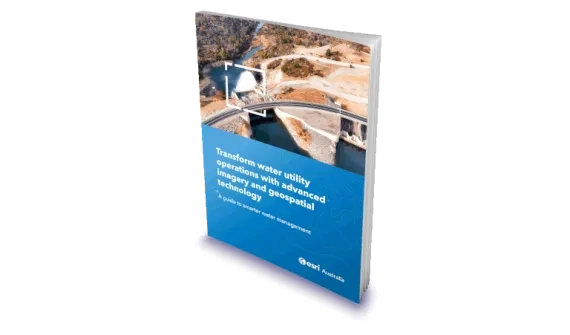Monitor, manage, and optimise your water resources like never before.
Make smarter, data-driven decisions, with high-resolution satellite imagery, drone data collection, and Light Detection and Ranging (LiDAR) technology.
Esri’s solutions give you the critical insights to manage assets, track environmental changes, and ensure compliance seamlessly across your water utility.
Why chose an Esri solution?
Utilise advanced imagery and geospatial analytics to track infrastructure performance, identify maintenance needs, detect leaks early, and prevent water loss.
Monitor floods and droughts in real time, identify flood-prone areas, and monitor water levels quickly and accurately.
Detect contaminants using remote sensing and drone technology.
Ensure scalability and resilience when designing and upgrading infrastructure using LiDAR and satellite data.
Increase resilience and sustainability with comprehensive mapping and flood monitoring.
Create dynamic, virtual models of your water infrastructure.
Want to learn more?
Download our eBook tailored for the water industry
Ready to explore possibilities? Register for a demo with a geospatial expert
FAQ
- What is reality mapping, and how does it benefit water utilities?
Reality mapping uses advanced geospatial technologies like satellite imagery, drone mapping, and Light Detection and Ranging (LiDAR) to create accurate, real-time visualisations of water infrastructure and surrounding environments. For water utilities, this means better monitoring of infrastructure performance, identifying potential risks (like leaks or floods), and planning maintenance and expansions with greater precision. With real-time insights, your team can respond faster and more effectively to emerging challenges.
- How can Esri’s remote sensing tools help with flood risk management?
Esri’s remote sensing solutions use high-resolution satellite imagery, LiDAR, and drone data to monitor water levels and pinpoint flood-prone areas. These tools allow for real-time flood mapping and predictive modelling, helping you proactively manage risks and reduce damage from extreme weather events. Get ahead of potential disasters and mitigate impacts before they occur.
- What types of water utility assets can Esri’s technology monitor?
Esri’s reality mapping technology can monitor a wide range of assets, including pipelines, reservoirs, water treatment plants, and pump stations. By providing detailed visualisations and data on the condition of these assets, you can schedule maintenance more efficiently, avoid unplanned outages, and ensure optimal performance across your entire network.
- How can I use Esri’s solutions to track water quality?
Esri’s drone and satellite technology can be used to monitor water quality by detecting contaminants, measuring water clarity, and tracking changes over time. This data is crucial for regulatory compliance and helps ensure the delivery of clean, safe water to your community.
- What is LiDAR, and why is it important for water utilities?
LiDAR is a remote sensing technology that uses laser light to create highly accurate 3D models of terrain and infrastructure. For water utilities, LiDAR is invaluable for infrastructure planning, flood risk assessment, and detecting topographical changes that could impact water resources.
- How does Esri’s technology help with regulatory compliance?
Esri’s tools provide real-time data and reporting that can help utilities meet local and national regulatory requirements. From tracking water quality to monitoring environmental impacts, you’ll have access to the data needed to prove compliance and prepare for audits.
- Can Esri’s solutions help with long-term infrastructure planning?
Yes. Esri’s reality mapping technology provides the insights you need to plan for future infrastructure upgrades and expansions. With precise data on existing assets and environmental conditions, you can make informed decisions that optimise performance, reduce costs, and ensure scalability.
- How quickly can I implement Esri’s Imagery & Remote Sensing solutions?
Esri’s solutions are designed to be scalable and flexible, meaning they can be integrated with your existing systems quickly and efficiently. Our team of experts will work with you to ensure a seamless deployment tailored to your specific needs.


